Technique for detecting the life | ||||
How to detect life on exoplanets? |  Automatic translation Automatic translation | Updated June 01, 2013 | ||
How to detect life on exoplanets? | Stefano Bagnulo, coauthor of the study, explains the concept: "the light of a distant exoplanet is largely lost in the glare of its star, it is therefore difficult to analyze. It's a bit like trying to study a speck of dust next to a powerful light bulb. The light reflected by a planet is polarized, while that of the star is not. |  | ||
Biosignatures | ||||
What biosignatures (life indicators), which will reveal the presence of life on distant exoplanets? | Enric Palle (Instituto de Astrofísica de Canarias, Tenerife, Spain): "Finding life outside the solar system depends on two things, first of all that life exists elsewhere, and if this is the case, having the ability technique to detect." | |||
Subtle traces of life | ||||
On 3 December 2013 the powerful Hubble Space Telescope NASA saw the subtle traces of water on alien worlds. Two teams of scientists have found weak signatures of water in foggy atmospheres five distant planets. The five planets are hot Jupiters, massive worlds orbiting close around their host stars. The presence of water in the atmosphere, has been previously reported on some exoplanets orbiting stars beyond our solar system. However this is the first study to measure conclusively, by comparing the profiles and intensities of these signatures on several worlds. The five planets studied are WASP-17b, HD209458b, WASP-12b, WASP-19b and XO-1b, all they orbit close to their star. Of course, the signal strength of their signatures of water varies depending on their atmosphere. For example, WASP-17b is a planet with a particularly dense atmosphere, while HD209458b has the strongest signals. Signatures for the other three planets, WASP-12b, WASP-19b and XO-1b, are also compatible with the presence of water. | Image: This NASA video explains how researchers are studying the characteristics of exoplanets, especially the size and atmospheric composition. Exoplanets are too distant to be seen directly, but through the light absorbed by passing in transit to their star, scientists can infer by indirect methods, many hidden features such as mass, density, composition (rocky or gaseous ), the depth of its atmosphere. All this information is encrypted while in transit in the color of the light absorbed. Each wavelength absorbed in the light spectrum reveals a distinct molecular chemical footprint. Which most interested researchers are signs of life such as water vapor (H2O), oxygen (O2) and methane (CH4). | |
Life on Earth, in fast | ||||
About 500 million years after the birth of the Earth, bacteria appear, are simple cells without nucleus (prokaryotes), and will evolve for 1.5 billion years until eukaryotic bacteria with a core 2 billion years after the birth of the Earth, the expected occasion is and multicellular organisms appear. Complexity will then accelerate its walking in front, even 100 million years to see shellfish, and crustaceans. Another 100 million years and the fish appear. | There are 200 million years, birds and reptiles make their appearance, 50 million years later it was the turn of the dinosaurs. There are 100 million years, mammals invade the earth. There are 20 to 30 million years are the primates who show their teeth and there are about 6 million years, the lineage of Homo sapiens entered the earthly scene. It took the universe, invent galaxies, stars, planets, oceans and atmospheres, under skies still more conducive to achieve the complexity observable today. | ? consciences organisms cells organic molecules or proteins simple molecules atoms nucleons quarks, electrons chaos ? Image: The pyramid of complexity goes to the rarefaction. |
"The data available on this site may be used provided that the source is duly acknowledged."



 Discovery of solid buckyballs
Discovery of solid buckyballs
 Are we alone in the universe ?
Are we alone in the universe ?
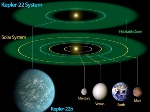 Kepler 22b, a small exoplanet in the habitable zone of Kepler 22
Kepler 22b, a small exoplanet in the habitable zone of Kepler 22
 Rama, extraterrestrial ship
Rama, extraterrestrial ship
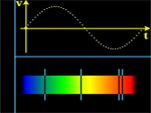 Detection of exoplanets
Detection of exoplanets
 Cheops, characteristics of exoplanets
Cheops, characteristics of exoplanets
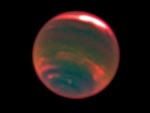 Mini-Neptunes or gas dwarfs
Mini-Neptunes or gas dwarfs
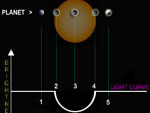 Turn off the stars and see the exoplanets
Turn off the stars and see the exoplanets
 Discovery of 6 Earth-sized planets
Discovery of 6 Earth-sized planets
 Four or five stars are born every year
Four or five stars are born every year
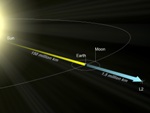 JWST, the end of the dark ages
JWST, the end of the dark ages
 Hundreds of billions of planets
Hundreds of billions of planets
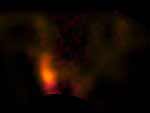 Protoplanet around the star HD100546
Protoplanet around the star HD100546
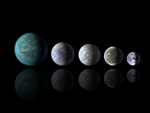 Two new planetary systems
Two new planetary systems
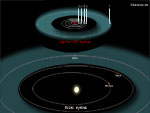 The habitable zone of the Kepler-186 system
The habitable zone of the Kepler-186 system
 Billions of floating planets
Billions of floating planets
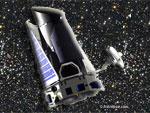 Kepler space telescope in search of life
Kepler space telescope in search of life
 Liquid water, accelerator of chemical reactions
Liquid water, accelerator of chemical reactions
 55 Cancri e, the diamond planet
55 Cancri e, the diamond planet
 Ashen light, the proofs of life
Ashen light, the proofs of life
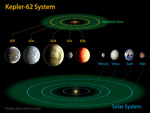 Number of candidate and confirmed exoplanets
Number of candidate and confirmed exoplanets
 Trappist or the harmony of the cosmos
Trappist or the harmony of the cosmos